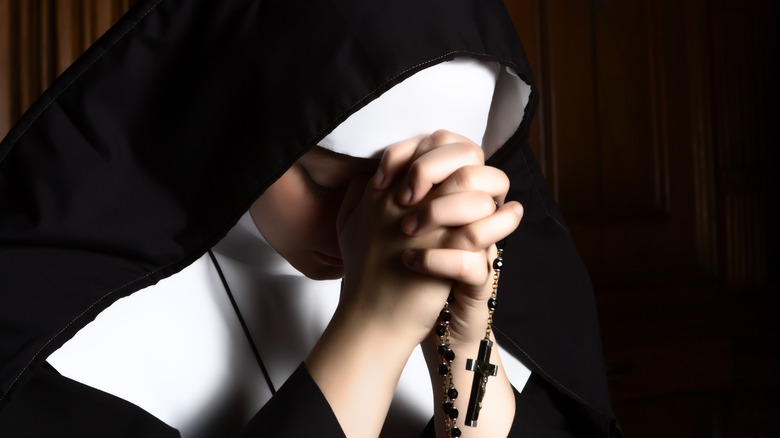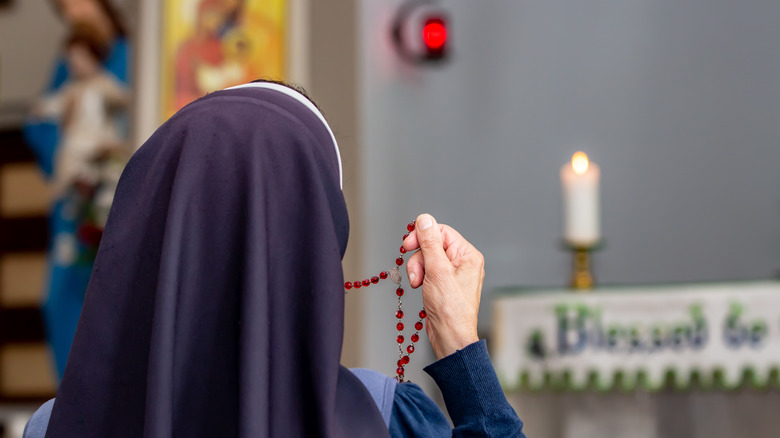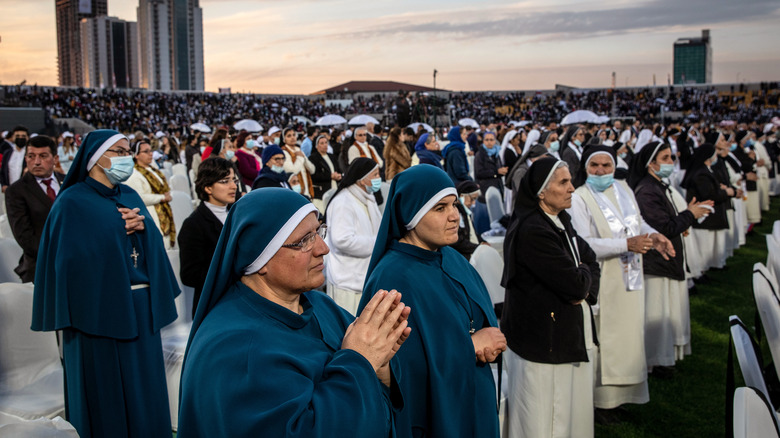Why Nuns Cover Their Hair
Even to those unfamiliar with Catholic beliefs, the idea of a nun should be pretty clear: a woman who's devoted her life to God. Specifics of sisterhood get a lot more complicated than that, but New Idea summarizes three core, familiar tenets that nuns have to follow: faith, poverty, and chastity. Nuns of all orders — Benedictines, Carmelites, Dominicans, and so on — also have to follow a daily schedule that typically incorporates a lot of prayer, housework, cooking, etc., like that listed on the website of the Benedictines in Herefordshire, England. And of course, there's the very familiar outfit that nuns wear, called a "habit" — sometimes black and white, sometimes grey, sometimes blue, and so forth. All nun habits, however, contain one critical component: a headpiece, oftentimes simply called a veil, per Theosis Christian.
Veils and other head coverings aren't exactly unique to Catholicism, or nuns for that matter. The Pew Research Center says that 89%, 86%, and 59% of Muslim, Sikh, and Hindu women, respectively, wear head coverings of some type outside of the home. The same is true for 84% and 69% of Muslim and Sikh men. Jewish men might wear yarmulkes, and married Orthodox Jewish women wear wigs in public. Catholic bishops might wear a miter — those tall, conical hats — during services. But in all cases, one's head is considered a point of connection to the divine, and covering it is a symbol of piety in the face of the Almighty.
The origins of a tradition
For Biblical literalists out there, St. Paul in the New Testament has pretty clear-cut rules about women covering their heads. In his first letter to the Corinthians, chapter 11, he writes, " ... [E]very woman who prays or prophesies with her head uncovered dishonors her head — it is the same as having her head shaved. For if a woman does not cover her head, she might as well have her hair cut off; but if it is a disgrace for a woman to have her hair cut off or her head shaved, then she should cover her head." Paul opens this passage by talking about "holding to the traditions," indicating that the idea of women keeping their heads covered when engaged in religious practices was longstanding even by then.
Theosis Christian simply says that the nun veil has "medieval" roots. As Angelus News says, as early as the 3rd century ardent Christian believers adopted a monastic lifestyle devoted wholly to God and living separately from the rest of society. Per The Collector, it took until the 6th century C.E. for St. Benedict to found Catholicism's first monastic order, the Benedictines. Women didn't partake in monastic traditions until much later in the 13th century as an offshoot of the Franciscans, when St. Francis ordained Saint Clare of Assisi in 1212, per S.D. Cason Catholic Gallery. St. Clare, as Meghan Ashley Styling says, shaved her head as a sign of piety, and covered it with a veil.
Piety before God
Following in the tradition and habit (excellent pun intended) of St. Clare, nuns of Catholic orders have continued to cover their heads. Theosis Christian says that nuns sometimes shave their heads, too. Going back to 1 Corinthians 11, Paul says that long hair on a woman "is her glory," and that God gave women long hair "as a covering." By this rationale, cutting one's hair symbolizes a further removal from worldly attachments, vanity, and, as Theosis Christian says, the desire to get married. Meghan Ashley Styling reiterates this point by saying that a veil is a "sign of consecration" to God, like wearing a wedding gown every day. And indeed, as Catechist says, nuns are often referred to as "brides of Christ." Theosis Christian also goes into further detail about different types of veils, including white veils for novices and black veils over the faces for certain ceremonies.
Because traditions always encounter pushback from subsequent generations, Head Covers makes it clear that veils are not intended to suppress women or indicate some kind of inferior status. It's rather the opposite: veils are meant to signify an exalted status, behaving like protection for something sacred. This sentiment is shared by Islam, as Why Islam says, where head coverings for women are intended as a sign of modesty. Some Muslim women choose to not wear a head covering, the site says, but this depends on their "personal connection" with their faith.


